The Ultimate Guide to Column Radiators
Posted by Column Radiator 4u on 16th Oct 2025
Key Takeaways
- What are column radiators? Classic, stylish radiators made of vertical tubes. They're highly efficient because their design creates a large surface area for excellent heat output.
- Are column radiators efficient? Yes, very! They produce high heat (measured in BTUs) for their size, warming rooms quickly and effectively.
- How to choose the right size column radiator? This is crucial. Use an online BTU Calculator to work out your room's heating requirement before you buy. Your radiator's BTU output must meet or exceed this number.
- What are my main choices?
- Orientation: Classic horizontal (under windows) or modern, space-saving vertical.
- Depth: More columns (e.g., 4-column vs 2-column) means more depth and higher heat output.
- Finish: Popular choices include classic white, modern anthracite, matt black, and industrial bare metal lacquer.
- Installation: Check your wall type. Solid masonry is fine for wall mounting. For plasterboard walls, you must fix to the internal studs or use floor-standing feet for support.
- Don't forget to accessorise: Matching valves and pipe covers are essential for a professional, polished look.
For decades, the column radiator has been a cornerstone of British home heating, celebrated for its timeless elegance, superior performance, and remarkable versatility. It’s a design that feels just as at home in a traditional Victorian terrace as it does in a sleek, contemporary new-build apartment.
Whether you’re renovating a period property, looking for an efficient heating solution, or simply want to add a touch of architectural style to your space, the column radiator is an exceptional choice. But with so many sizes, styles, and finishes available, where do you begin?
This guide is designed to be your single source of truth. We’ll cover everything you need to know about column radiators, from the fundamental principles of how they work and why they are so efficient, to the practical details of choosing the perfect model, style, and accessories to bring warmth and character to your home.
First Things First: What Are Column Radiators?
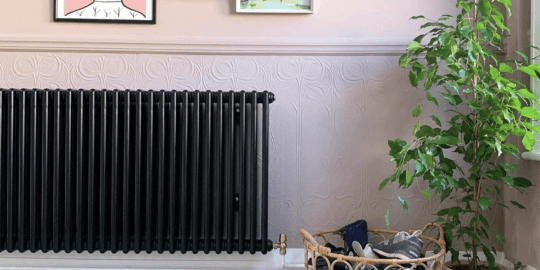
At its core, a column radiator is a simple yet ingenious piece of engineering. It’s constructed from a series of vertical hollow tubes, or ‘columns’, which are welded to horizontal connecting pieces at the top and bottom. This creates a single, interconnected unit.
When your central heating is on, hot water flows from your boiler through these columns. The heat from the water transfers to the metal surface of the tubes, which in turn radiates warmth out into the room. This classic design isn’t just for show; it’s absolutely fundamental to the radiator’s exceptional heating performance.
One of the greatest strengths of the column radiator is its versatility. They are available in a huge array of configurations, including:
- Horizontal models: The classic landscape orientation, perfect for positioning under windows.
- Vertical models: A tall, space-saving option that adds a dramatic, modern flair to any room.
- Varied depths: From slim 2-column designs to powerful 6-column radiator models, allowing you to tailor the heat output without changing the radiator's height or width.
This adaptability means there is a column radiator to suit virtually any space, style, or heating requirement.
How Column Radiators Work
To truly appreciate the column radiator, it helps to understand the science behind its brilliant design. It all comes down to maximising surface area to deliver heat efficiently and effectively.
The Fundamentals of Heat Transfer
The basic principle of any radiator is to transfer thermal energy from the hot water inside it to the air in your room. The most effective way to do this is to have a very large surface area.
This is where the multi-column design excels. A row of vertical tubes has a significantly larger total surface area than a single flat panel of the same height and width. Think of it like the page of a book – a folded-out map has a much larger area than the cover it fits inside.
This increased surface area allows the radiator to heat your room using a powerful combination of two methods:
- Radiant Heat: The entire surface of the radiator emits warmth in the form of infrared radiation, which travels through the air and warms objects and people directly. It’s the same cosy feeling you get from an open fire.
- Convected Heat: As air comes into contact with the radiator, it heats up, becomes less dense, and rises. This draws cooler air in from the bottom of the radiator, which is then heated in turn. This creates a natural, continuous circulation of warm air around the room.
The synergy between these two processes ensures a rapid, even, and comfortable distribution of heat.
The Design of Column Radiators
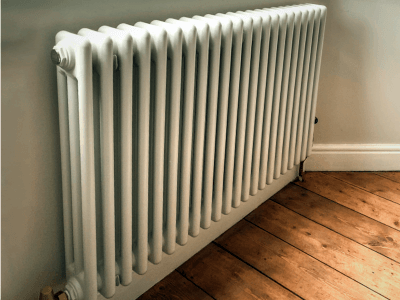
Column radiator design is about more than looks; performance is also, of course, every bit as important. The number of columns directly relates to the radiator's depth and, in turn, its heat output. When you see a radiator described as "2-column," "3-column," or "4-column," this refers to the number of vertical tube rows it has when viewed from the side:
- 2-Column: A slim, elegant profile, ideal for hallways, smaller rooms, or areas where space is tight.
- 3-Column: Arguably the most popular choice, 3-column radiators offer an excellent balance of high heat output and a classic, substantial look without projecting too far from the wall.
- 4-Column (and above): With a greater depth and surface area, 4-column radiators produce a very high heat output, making them perfect for large, open-plan spaces, rooms with high ceilings, or areas that are traditionally hard to heat.
Generally, for any given height and width, the more columns a radiator has, the higher its heat output will be.
Are Column Radiators Efficient?
This is one of the most common questions we hear, and the answer is a resounding yes. Modern column radiators are an extremely efficient way to heat your home.
Their efficiency stems directly from their design. The large surface area we discussed allows them to release a tremendous amount of radiant and convected heat into a room for their given size. This heat output is measured in BTUs (British Thermal Units). Often, a column radiator will have a higher BTU rating than a standard panel radiator of the same height and width, meaning it can heat the space more quickly and effectively.
Furthermore, the materials used in their construction also play a vital role. The vast majority are made from mild steel, which is an excellent conductor of heat. This allows them to heat up very quickly when your boiler kicks in and cool down relatively fast when it turns off. It’s this responsiveness that gives you precise control over your home's temperature, preventing wasted energy from overheating and ensuring you are only using heat when you need it.
Materials Used in Column Radiators
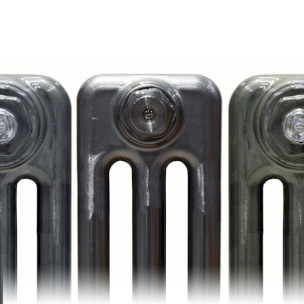
The material a radiator is made from affects its performance, longevity, and appearance. These are the most commonly found choices:
Mild Steel
Mild steel is the industry standard for column radiators, and for good reason. It strikes the perfect balance between performance and value.
- Durability: Steel is an incredibly strong and robust material, built to withstand the pressures of a modern central heating system for decades.
- Heat Conductivity: It’s also a fantastic conductor, allowing for the rapid transfer of heat from the water to the room.
- Versatility: Steel is easy to work with and can be finished in an almost limitless range of colours and finishes, from classic white paint to modern anthracite powder coats and raw metal lacquers.
- Affordability: Compared to other materials, mild steel offers exceptional performance for its price point, making it the most popular choice for homeowners across the UK.
Aluminium
While less common, aluminium is a premium material used for high-end column radiators. It offers several distinct advantages:
- Lightweight: Aluminium is significantly lighter than steel, making installation easier, especially for large models or on walls where weight is a concern.
- Rapid Heat-Up: It’s an even better conductor than steel, meaning aluminium radiators can reach their target temperature incredibly quickly, offering near-instantaneous warmth.
- Corrosion-Resistant: Aluminium has a natural resistance to rust and corrosion.
How Do Column Radiators Compare to Other Radiators?
Every radiator type has its place, and understanding the differences can help you make the best choice for your home's specific needs and aesthetic.
|
Radiator Type |
Aesthetics |
Heat Output |
Heat-up Speed |
Cost |
Weight |
|
Column Radiator |
Timeless, classic, and versatile. Suits both traditional and modern interiors. Available in many colours. |
Very High |
Fast |
££ |
Moderate to Heavy |
|
Panel Radiator |
Functional and unobtrusive. The standard modern radiator, although may lack character. |
Good |
Fast |
£ |
Light |
|
Cast Iron Radiator |
Ornate, traditional, and grand. A true statement piece for period properties. |
Excellent (high thermal mass) |
Slow |
£££ |
Very Heavy |
|
Designer Radiator |
Varies hugely. Can be sculptural, minimalist, or bold. Focus is on form over function. |
Varies |
Varies |
££££ |
Varies |
Understanding Column Radiator Sizes
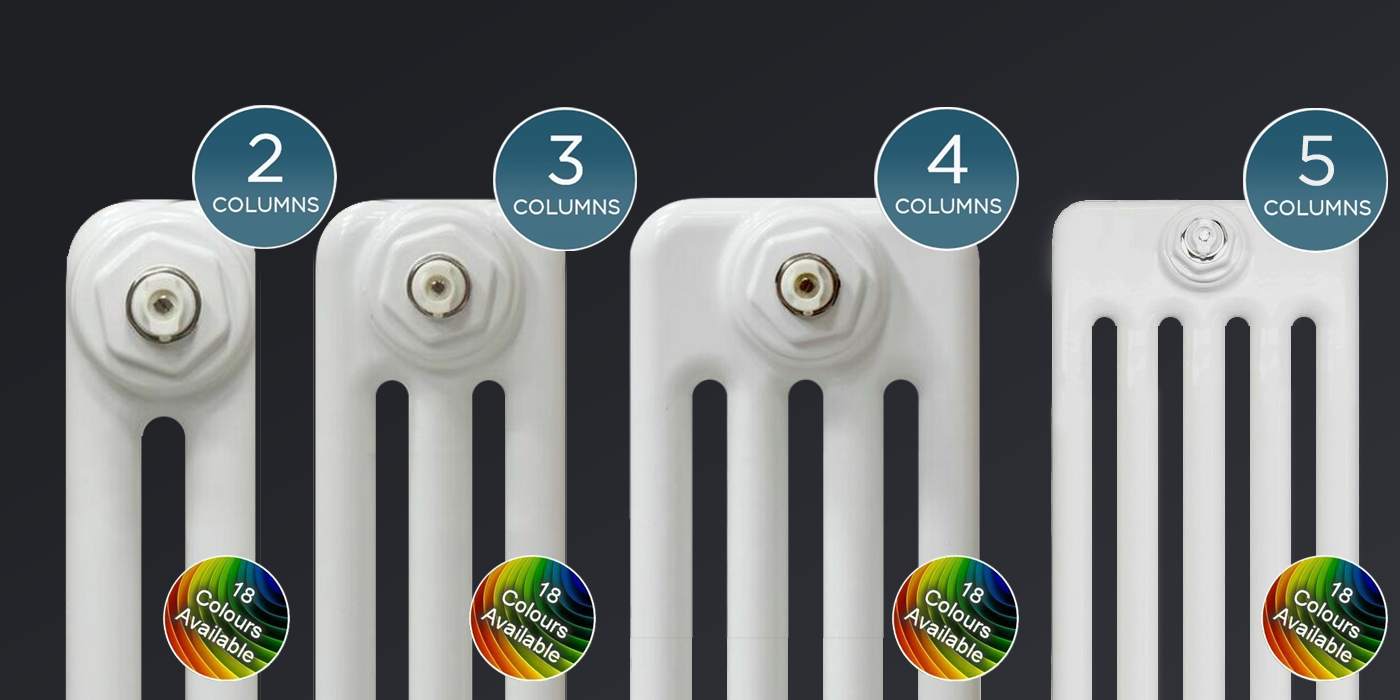
Choosing the right size radiator doesn’t just mean finding one that fits your available wall space - you also need to ensure the radiator has enough power to heat your room. There are three key dimensions to consider:
- Height: The vertical measurement from top to bottom. Column radiators are available in a vast range of heights, from low-level models around 300mm tall to towering vertical units over 2000mm.
- Width: The horizontal measurement from side to side. This is often dictated by the space you have available, for instance, the width of an alcove or the space beneath a window.
- Depth (Columns): As explained earlier, this is how many rows of tubes the radiator has (e.g., 2, 3, or 4 columns). A deeper radiator will have a higher heat output but will also project further from the wall, which is an important consideration for hallways and high-traffic areas.
What Size Column Radiator Do I Need?
This is the single most important question to answer before you buy. Choosing a radiator that is too small will result in a room that never feels truly warm. Choosing one that is too large means you’ve spent more than you need to!
The key is to calculate your room's heating requirement, which is measured in BTU (British Thermal Units).
In simple terms, a BTU is a unit of energy. A BTU calculation tells you exactly how many units of heat energy are required per hour to heat your specific room to a comfortable temperature (usually around 21°C).
To find out your room's required BTU, you need to use an online BTU calculator. These tools are simple to use and will ask for key information such as:
- Room dimensions (length, width, and height).
- The number and type of windows (e.g., single or double-glazed).
- What is above and below the room (e.g., another heated room or an uninsulated loft).
- The number of external walls.
Once you have your final BTU figure, you can shop with confidence. Simply choose a radiator (or a combination of radiators in a large room) with a total heat output that meets or exceeds this requirement. To make this as easy as possible, every radiator on our website clearly states its BTU output, making it easy to find a model with the right power for your space.
Find your perfect radiator size with our free BTU Calculator!
Column Radiator Colours, Finishes, and Styles
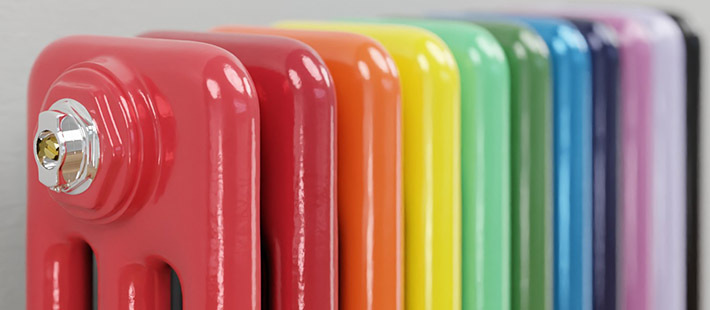
Long gone are the days when a radiator was just a functional white box! Today, they are a key part of your interior design scheme.
Colours & Finishes
To help you really match your heating system to your interior decor scheme, here at Column Radiators 4u, we offer our radiators in a huge range of finishes, including:
- White: A timeless, clean, and versatile choice that effortlessly blends with any decor.
- Anthracite grey: A hugely popular modern finish. This dark, sophisticated grey adds a touch of contemporary industrial style, pairing beautifully with a wide range of colour palettes.
- Black: A bold, dramatic option that creates a stunning focal point and works perfectly in minimalist or monochrome schemes.
- Bare metal lacquer: For a truly authentic, industrial look. This finish showcases the raw beauty of steel, including the weld marks, with a clear protective lacquer. Each radiator is unique.
- Custom RAL Colours: For the ultimate bespoke design, many of our radiators can be custom-painted in any RAL colour you desire, allowing you to perfectly match your walls, cabinetry, or other design elements.
Styles & Orientations
Aside from the finish of your column radiator, you can also choose the orientation that perfectly suits your wallspace:
- Horizontal column radiators: The traditional format. These radiators are masters of distributing heat evenly and are perfectly proportioned to fit under windows, where they work to counteract the cold air from the glass.
- Vertical column radiators: A stylish and practical solution for modern living. Vertical column radiators draw the eye upwards, making a room feel taller. They are a brilliant space-saver, ideal for kitchens where wall space is at a premium, narrow hallways, or for creating a stunning design statement in a living room.
How to Mount a Column Radiator
Due to their steel construction, column radiators can naturally be heavy, so a secure and safe installation is paramount. You have two main options for mounting:
Wall Mounting (Brackets)
This is the most common installation method. Your new radiator will be supplied with the correct number of robust brackets designed to support its specific size and weight.
It is crucial to consider your wall type:
- Masonry Walls: Solid brick or block walls provide a very strong fixing point.
- Plasterboard / Stud Walls: These walls are not strong enough to hold the weight of a column radiator on their own. The brackets must be fixed directly into the wooden studs behind the plasterboard. If this is not possible, you should opt for floor mounting. Always use appropriate specialist fixings for plasterboard.
Floor Mounting (Feet)
Floor-standing feet are an elegant and practical solution in two key scenarios:
- For Weaker Walls: If you have a stud wall and cannot align the brackets with the timber studs, column radiator feet provide the perfect answer. They transfer the majority of the radiator's weight directly to the floor.
- For a Classic Aesthetic: A floor-mounted radiator has a wonderful, traditional, freestanding appearance that is highly desirable in period properties.
Important Note: Even when using feet, you must still use wall stays. These are small brackets that secure the top of the radiator to the wall, preventing it from ever being accidentally tipped or pulled over. Safety must always come first.
Which Radiator Valves Work Best With Column Radiators?

Radiator valves are the essential connection between your pipework and your radiator, but they are also an effective design detail. Any standard 15mm radiator valve is compatible, but choosing a style that complements your radiator is the key to achieving a professional, polished finish.
There are also different types of radiator valves to choose from, depending on how you would like to control your heating system. Thermostatic radiator valves (TRVs) allow you to automate the heat output of individual radiators, while manual valves offer a simpler on/off function.
Then there’s the orientation of your valves. Depending on how your pipes are configured, you may need straight valves (ideal if your pipes come directly up from the floor), angled valves (suitable when pipes come out from the wall), or corner valves (a good option for a neat finish, especially if space is limited).
For Traditional Column Radiators
To complement a classic radiator in a period-style room, look for traditional radiator valves. These often feature elegant details and are available in finishes that match other hardware in your home.
- Styles: Look for crosshead or wheel-head handles.
- Finishes: Popular choices include antiqued finishes, polished, brushed, and pewter.
- Types: Both manual and thermostatic (TRV) options are available in traditional styles.
For Modern Column Radiators
For contemporary or industrial looks, consider modern radiator valves. These often feature more minimalist designs in a host of up-to-date colour choices.
- Styles: Look for sleek, simple designs. Angled or corner valves often provide the neatest look.
- Finishes: Match your radiator with anthracite, black, or contrast with a satin nickel or chrome.
- Types: Modern minimalist TRVs provide style and energy-saving temperature control.
Browse our range of column radiator valves today!
What Accessories Might I Need For My Column Radiator?
The small details make all the difference. To complete your installation to the highest standard, consider these essential column radiator accessories:
- Pipe covers/sleeves: Standard copper or plastic pipework can spoil the look of your beautiful new radiator. Pipe covers, also known as pipe sleeves, are metal tubes that slide over your pipes, giving a solid, high-quality finish from the valve to the floor. Always choose a finish that matches your radiator valves.
- Wall stays: As we mentioned earlier, wall stays are a crucial safety component. They brace the radiator against the wall, ensuring it is completely stable - which is especially important for tall vertical models and all floor-mounted radiators.
- Bleed valves & blanking plugs: Your radiator will come with these included. The bleed valve (or air vent) is a small valve at the top used to release trapped air from the system. The blanking plug seals the unused connection on the opposite side.
Which Column Radiator Should I Buy? A Scenario-Based Guide
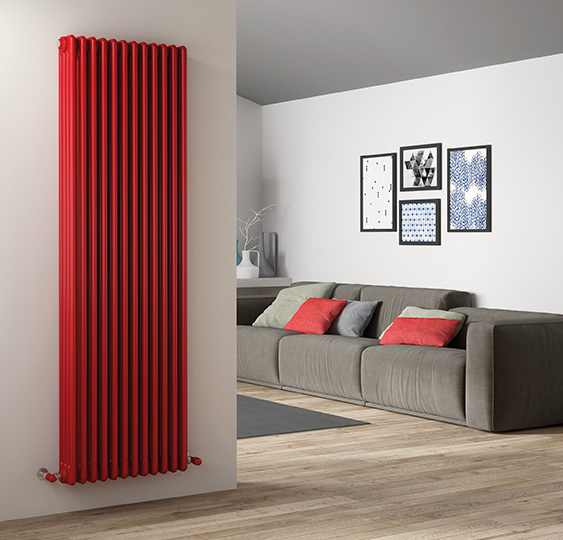
Feeling overwhelmed? Don't be! Simply walk through our easy checklist below to narrow down your options and find the perfect radiator for you:
- Function: First and foremost, what is your room's required BTU output? Use our BTU calculator and filter your search to only show radiators that meet or exceed this number.
- Space: Look at your available wall space. Is there a wide area under a window perfect for a horizontal model, or is a tall, narrow wall crying out for a space-saving vertical radiator?
- Wall type: Is your wall solid masonry, or is it plasterboard? This will determine if you can wall mount freely or if you need to consider floor-standing feet for support.
- Style: What is the overall look of your room? Are you aiming for a classic, traditional look, or a clean, modern, and minimalist vibe?
- Finish: Do you want the radiator to blend in with a classic white, or make a statement with a bold anthracite or custom RAL colour?
- Budget: What is your price range? With our extensive collection, we have high-quality options to suit every budget.
Buy Your Perfect Column Radiators at Column Radiators 4u
At Column Radiators 4u, we live and breathe column radiators. We believe they offer the perfect blend of style, performance, and value for any home. Our commitment is to provide you with an extensive range of the highest quality radiators, backed by expert advice and exceptional service.
We stock a huge variety of sizes, styles, and finishes, all with clear BTU ratings to make your choice simple. Enjoy fast, free UK delivery and the peace of mind that comes from buying from the specialists.
Browse Our Full Range of Column Radiators Today
Have a question or need some advice on your project? Don’t hesitate to contact our friendly team on 02393 162 162.
Column Radiators Explained: FAQs
Do column radiators need wall stays?
Yes, a wall stay is a vital safety component. It secures the radiator to the wall to prevent it from being tipped over, which is especially important in homes with children or pets. They are mandatory for floor-mounted radiators and highly recommended for all tall or heavy wall-mounted models.
How do you paint column radiators?
First, ensure the radiator is completely cold and turned off. Clean it thoroughly to remove dust and grease. Lightly sand the surface to create a key for the new paint. Use a specialist radiator paint that is designed to withstand high temperatures and won't discolour. Apply thin, even coats with a brush or spray can, allowing each coat to dry fully.
How do you clean column radiators?
The gaps between the columns can attract dust. The easiest way to clean them is with a long, flexible microfibre duster or a specialist radiator brush. For a deeper clean, use a soft cloth with warm, soapy water, then dry thoroughly. Avoid using abrasive scourers which could damage the finish.
How do you bleed column radiators?
If you notice the top of your radiator is cold while the bottom is hot, it means there is trapped air. To bleed it, first turn off your central heating. Place a cloth under the bleed valve (the small square or screw-headed valve at the top). Use a radiator key to turn the valve anti-clockwise slowly. You will hear a hissing sound as the air escapes. As soon as water starts to drip out, tighten the valve clockwise.
Are column radiators better than panel radiators?
"Better" depends on your priorities. Column radiators generally have a higher heat output for their size, offer a more classic and stylish aesthetic, and come in a wider range of designs. Panel radiators are typically cheaper and lighter, but can be less inspiring visually. For performance and style, many people consider column radiators a superior choice.
-

Trade Essentials White 3 Column Radiator H600 x W1220
Price:£334.50 -

Trade Essentials White 3 Column Radiator H600 x W990
Price:£283.04 -
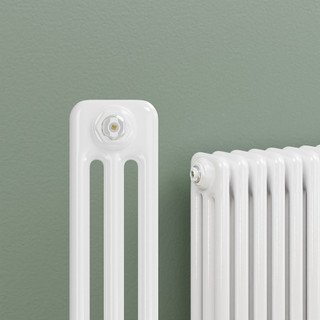
Trade Essentials White 3 Column Radiator H600 x W806
Price:£231.58 -
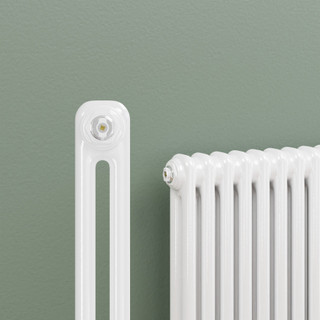
Trade Essentials White 2 Column Radiator H600 x W622
Price:£168.54 -

Trade Essentials White 2 Column Radiator H600 x W990
Price:£285.22 -
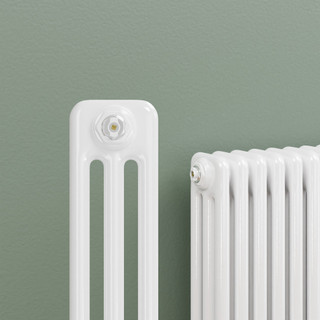
Trade Essentials White 3 Column Radiator H600 x W1864
Price:£514.62



